9.3: Relationship Types
( \newcommand{\kernel}{\mathrm{null}\,}\)
The line that connects two tables, in an ERD, indicates the relationship type between the tables: either identifying or non-identifying. An identifying relationship will have a solid line (where the PK contains the FK). A non-identifying relationship is indicated by a broken line and does not contain the FK in the PK. See the section in Chapter 8 that discusses weak and strong relationships for more explanation.
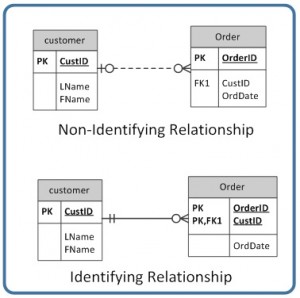
Optional relationships
In an optional relationship, the FK can be null or the parent table does not need to have a corresponding child table occurrence. The symbol, shown in Figure 9.3.2, illustrates one type with a zero and three prongs (indicating many) which is interpreted as zero OR many.

For example, if you look at the Order table on the right-hand side of Figure 9.3.3, you’ll notice that a customer doesn’t need to place an order to be a customer. In other words, the many side is optional.
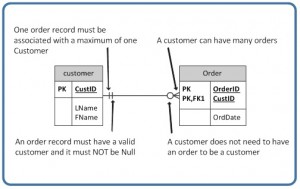
The relationship symbol in Figure 9.3.3 can also be read as follows:
- Left side: The order entity must contain a minimum of one related entity in the Customer table and a maximum of one related entity.
- Right side: A customer can place a minimum of zero orders or a maximum of many orders.
Figure 9.3.4 shows another type of optional relationship symbol with a zero and one, meaning zero OR one. The one side is optional.

Figure 9.3.5 gives an example of how a zero to one symbol might be used.
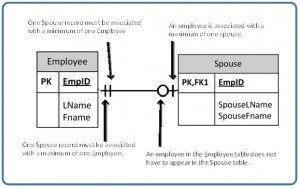
Mandatory relationships
In a mandatory relationship, one entity occurrence requires a corresponding entity occurrence. The symbol for this relationship shows one and only one as shown in Figure 9.3.6. The one side is mandatory.

See Figure 9.3.7 for an example of how the one and only one mandatory symbol is used.
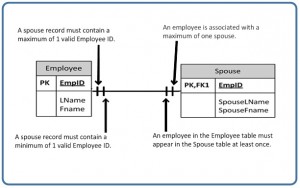
Figure 9.3.8 illustrates what a one to many relationship symbol looks like where the many side is mandatory.

Refer to Figure 9.3.9 for an example of how the one to many symbol may be used.
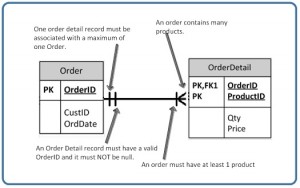
So far we have seen that the innermost side of a relationship symbol (on the left-side of the symbol in Figure 9.3.10) can have a 0 (zero) cardinality and a connectivity of many (shown on the right-side of the symbol in Figure 9.3.10), or one (not shown).

However, it cannot have a connectivity of 0 (zero), as displayed in Figure 9.3.11. The connectivity can only be 1.

The connectivity symbols show maximums. So if you think about it logically, if the connectivity symbol on the left side shows 0 (zero), then there would be no connection between the tables.
The way to read a relationship symbol, such as the one in Figure 9.3.12, is as follows.
- The CustID in the Order table must also be found in the Customer table a minimum of 0 and a maximum of 1 times.
- The 0 means that the CustID in the Order table may be null.
- The left-most 1 (right before the 0 representing connectivity) says that if there is a CustID in the Order table, it can only be in the Customer table once.
- When you see the 0 symbol for cardinality, you can assume two things: T
- the FK in the Order table allows nulls, and
- the FK is not part of the PK since PKs must not contain null values.
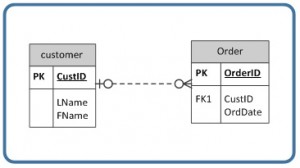
Key Terms
business rules: obtained from users when gathering requirements and are used to determine cardinality
cardinality: expresses the minimum and maximum number of entity occurrences associated with one occurrence of a related entity
connectivity: the relationship between two tables, e.g., one to one or one to many
constraints: the rules that force DBMSs to check that data satisfies the semantics
entity integrity: requires that every table have a primary key; neither the primary key, nor any part of it, can contain null values
identifying relationship: where the primary key contains the foreign key; indicated in an ERD by a solid line
integrity constraints: logical statements that state what data values are or are not allowed and which format is suitable for an attribute
mandatory relationship:one entity occurrence requires a corresponding entity occurrence.
non-identifying relationship: does not contain the foreign key in the primary key; indicated in an ERD by a dotted line
optional relationship: the FK can be null or the parent table does not need to have a corresponding child table occurrence
orphan record: a record whose foreign key value is not found in the corresponding entity – the entity where the primary key is located
referential integrity: requires that a foreign key must have a matching primary key or it must be null
relational database management system (RDBMS): a popular database system based on the relational model introduced by E. F. Codd of IBM’s San Jose Research Laboratory
relationship type: the type of relationship between two tables in an ERD (either identifying or non-identifying); this relationship is indicated by a line drawn between the two tables.
Exercises
Read the following description and then answer questions 1-5 at the end.
The swim club database in Figure 9.5.16 has been designed to hold information about students who are enrolled in swim classes. The following information is stored: students, enrollment, swim classes, pools where classes are held, instructors for the classes, and various levels of swim classes. Use Figure 9.5.16 to answer questions 1 to 5.

The primary keys are identified below. The following data types are defined in the SQL Server.
tblLevels
Level – Identity PK
ClassName – text 20 – nulls are not allowed
tblPool
Pool – Identity PK
PoolName – text 20 – nulls are not allowed
Location – text 30
tblStaff
StaffID – Identity PK
FirstName – text 20
MiddleInitial – text 3
LastName – text 30
Suffix – text 3
Salaried – Bit
PayAmount – money
tblClasses
LessonIndex – Identity PK
Level – Integer FK
SectionID – Integer
Semester – TinyInt
Days – text 20
Time – datetime (formatted for time)
Pool – Integer FK
Instructor – Integer FK
Limit – TinyInt
Enrolled – TinyInt
Price – money
tblEnrollment
LessonIndex – Integer FK
SID – Integer FK (LessonIndex and SID) Primary Key
Status – text 30
Charged – bit
AmountPaid – money
DateEnrolled – datetime
tblStudents
SID – Identity PK
FirstName – text 20
MiddleInitial – text 3
LastName – text 30
Suffix – text 3
Birthday – datetime
LocalStreet – text 30
LocalCity – text 20
LocalPostalCode – text 6
LocalPhone – text 10
Implement this schema in SQL Server or access (you will need to pick comparable data types). Submit a screenshot of your ERD in the database.
- Explain the relationship rules for each relationship (e.g., tblEnrollment and tblStudents: A student can enroll in many classes).
- Identify cardinality for each relationship, assuming the following rules:
- A pool may or may not ever have a class.
- The levels table must always be associated with at least one class.
- The staff table may not have ever taught a class.
- All students must be enrolled in at least one class.
- The class must have students enrolled in it.
- The class must have a valid pool.
- The class may not have an instructor assigned.
- The class must always be associated with an existing level.
- Which tables are weak and which tables are strong (covered in an earlier chapter)?
- Which of the tables are non-identifying and which are identifying?

